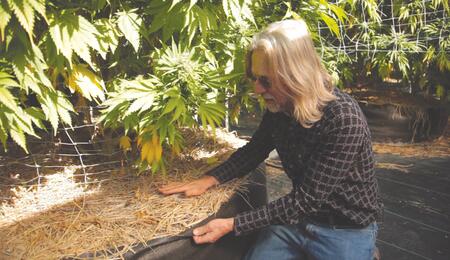Irrigation

Large plants use more water than small plants, but there are many more variables than size that dictate a plant's water consumption. Some of the variables include, variety and age of the plant, container size, growing medium, temperature, humidity and ventilation all contribute to water needs.
Change any one of these variables and the water consumption will change. Good air circulation and ventilation are essential to promote a free flow of fluids, transpiration and rapid growth. The healthier a plant, the faster it grows and the more water it needs. For example, a small 4 × 4-foot (120 x 120 cm) garden containing 16 healthy plants in 3-gallon (11 L) pots needs 10 to 25 gallons (40-100 L) of water per week. A big 12-foot-tall (3.6 m) plant growing rapidly can use up to 10 gallons (38 L) of water on a hot sunny day.
Drip irrigation tubing is easy to move to individual pots so that they receive the exact amount of nutrient solution.
Irrigation basics are explained below. You must always keep these basics in mind as you develop your knowledge and skill as to when and how much to irrigate your garden. Stay close to your plants and you will understand their needs. Moisture meters take the guesswork out of water penetration in soil and soilless mixes. The probe is inserted into the soil that measures moisture content at the tip. A readout is displayed on an analog wet-to-dry scale at the top of the device. I´m always surprised how unevenly some soils and soilless mixes hold water. Dry soil pockets surrounded by wet substrate impairs moisture and nutrient uptake. Roots suffer stress growth is slower. I use an inexpensive ($20) meter. More expensive meters send collected information to your digital device where it is compiled, analyzed and presented in a numeric or graphic format. An irrigation schedule will keep you and your garden on track. Alter the irrigation schedule in relation to wind, heat and humidity. Plants use more water when temperatures climb and when it is windy. Plants use less water when temperatures cool and humidity increases. Always check the ground moisture manually before and after irrigating.
Saturate the soil in a container and put it on the scal to record the weight.
Irrigate early in the day so that water that splashed on leaves has a chance to dry. Avoid wetting foliage and do not let water sit on leaves overnight to avoid diseases. Small plants with a small root system in small containers must be watered often. Water small containerized plants frequently, as soon as the soil surface dries out. As long as the drainage is good, it is difficult to overwater fast-growing cannabis. Four-week-old clones flowering in 2-3-gallon (7.5-11 L) containers require irrigation daily. If exposed to direct sunlight and wind, small containers dry out very quickly and may need watering twice daily. Irrigate cannabis in containers, regardless of size, when half the water is used. To figure out when half the water is used, saturate the soil in the container until water flows from the drainage holes in the bottom. At this point the soil contains 100 percent water mixed with the growing medium. Weigh the container. Let´s say it weighs 10 kg. Wheen 50 percent of the water is used, the container weighs 5 kg. After weighing a few containers, you will soon develop the experience and skill to lift the container and make a very close educated guess as to when to irrigate. The next step will be to tip the container to figure out when to irrigate. Another method is to irrigate containerized plants when the soil is dry one-half inch below the surface. This method works OK but does not account for container size and is less precise. Allow at least 10 percent of the of the water to drain out the holes in the bottom of the container. The runoff carries away excess fertilizer salts that have built up in the soil. Organize containers in straight lines so that it is easy to keep track of plants that need water and the ones that have been irrigated. It is very easy to miss a container when there are several hundred to water. Lightly cultivate the soil surface in containers to allow the water to penetrate evenly and guard against dry pockets that do not get wet. It also keeps the water in containers from running down the crack between the inside of the pot and the soil and out the drain holes. Gently break up and cultivate the top 1-2 cm of the soil with your fingers or small garden fork. Be careful not to disturb the tiny surface roots.
When the containerized plant weighs half as much, 50 percent of the water remains in the soil. It´s time to water.
Do not withhold water at any stage of cannabis growth. Cannabis requires a lot of water. Withholding water causes stress and stunts all stages of growth. Rationing water during flowering causes smaller flowers to grow that produce less. Plants suffering water stress are much more prone to a menagerie of problems. Water on a wet/dry schedule. Cannabis grows best when roots search for water and nutrients. Waiting to irrigate until the soil is a little dry sends roots in search of water, causing them to grow and penetrate more soil. Plants exposed to wind dry out much faster. Outdoor, terrace and patio plants will use up to four times or more water on a hot windy day. Keeping up with the watering is difficult for gardeners who travel, and it is time-consuming. An automated irrigation system that uses a timer will help keep the irrigation schedule consistent. Irrigate ground-grown cannabis when the soil is dry about an inch below soil surface. Recently transplanted cannabis will need watering more often the first few weeks, especially during warm to hot weather. When planted in cool weather, roots get a chance to grow downward and outward before hot weather hits. These transplants grow much better and require less frequent irrigation than if planted after the weather warms. Seedlings started directly in the soil or started indoors and moved outdoors early have a chance to develop a long taproot. The taproot grows deeply into the soil. Seedlings planted early in the year tend to be more drought-resistant than clones that have a much shallower root system. Reduce temperature stress and lower water consumption by applying mulch and growing under shade cloth. Apply mulch to protect soil from rain and the blazing sun. Mulch also attracts and holds moisture in the soil. Conserve much water by applying a thick layer of my favorite mulch, straw. See chapter 12, Outdoors, for practical information about using mulch. Install a semi-permeable shade cloth wind block to decrease wind in turbulent areas. Shade cloth makes a great easy-to-construct wind block. Wind sucks moisture from cannabis plants quickly, depleting energy and increasing water needs and plant stress. Put shade cloth above outdoor gardens to keep them degrees cooler which in turn lowers water requirements and plant stress.
A water wand with a shower-type head aerates water and disperses it evenly. You can reach more places with a wand and avoid broken foliage.
Overwatering is a common problem, especially when growing in heavy soil that drains poorly. Too much water drowns the roots by cutting off their supply of oxygen. Roots literally suffocate from lack of oxygen if allowed to sit in water for more than 20 minutes. Overzealous gardeners that love their gardens so much they give plants too much water are often the cause of overwatering. Plants use less water and are more prone to overwatering when air flow is limited, and humidity is high. Signs of overwatering include leaves that curl down at the edges and slow growth. Waterlogged, soggy soil promotes root rot and other water-borne diseases. Initial symptoms of overwatering are often subtle and inexperienced gardeners may not see any outright symptoms until damage has occurred. Underwatering can cause serious problems if unchecked. By the time a cannabis plant wilts, it has been water-starved for a day or longer and damage has started to occur. Plants start to shut down to conserve moisture and growth slows, even stops. If soil becomes bone dry, tender root hairs dry out and soon die. Dry soil, even in pockets, can cause root hairs dry up and die. It seems to take forever for the roots to grow new root hairs and resume rapid growth. Water use increases with rapid growth coupled with hot weather, bright sunshine, sunbaked soil and wind. This water must be replaced quickly, or plants suffer water stress. Soil in small containers dry quickly. Fast-growing cannabis in small containers often requires daily watering. If a single container is forgotten, water-starved plant could become stunted and never resume rapid growth. Prevent underwatering by checking moisture levels regularly especially when temperatures rise and when wind increases. Apply mulch to soil outdoors once soil warms, grow plants in small containers under shade cloth.
A moisture meter is indispensible when checking soil moisture.
To ensure soil is completely wet add two drops per liter or quart of water to a biodegradable, concentrated liquid soap like Castille®. The soap acts as a wetting agent by helping the water penetrate the soil more efficiently. This also guards against dry soil pockets. Most soluble fertilizers contain a wetting agent. If soil is difficult to wet, apply about one-quarter to one-half as much water as the plant is expected to need and then wait 10 to 15 minutes for it to totally soak in. Apply more water until the soil is evenly moist. Submerge small containers in water to ensure soil is soaked. Fill a large container with water. Hold your hand over the soil and submerge the small pot until the growing medium is completely saturated. Submerge pots in water no more than 20 minutes or roots will literally drown. Set container in bucket of water and wait for it to sink, then you know it is saturated because the soil and the water are the same weight. Set pots on saucers to keep drainage water contained. An automattic watering system keeps irrigation more consistent. A timer doses out water at a specific time before turning off. Water sensors can also turn the automated irrigation system on and off. Drip system emitters can be set to dole out specific volumes of water per hour. See “Irrigating and Fertigating” below for more information on automated irrigation.



